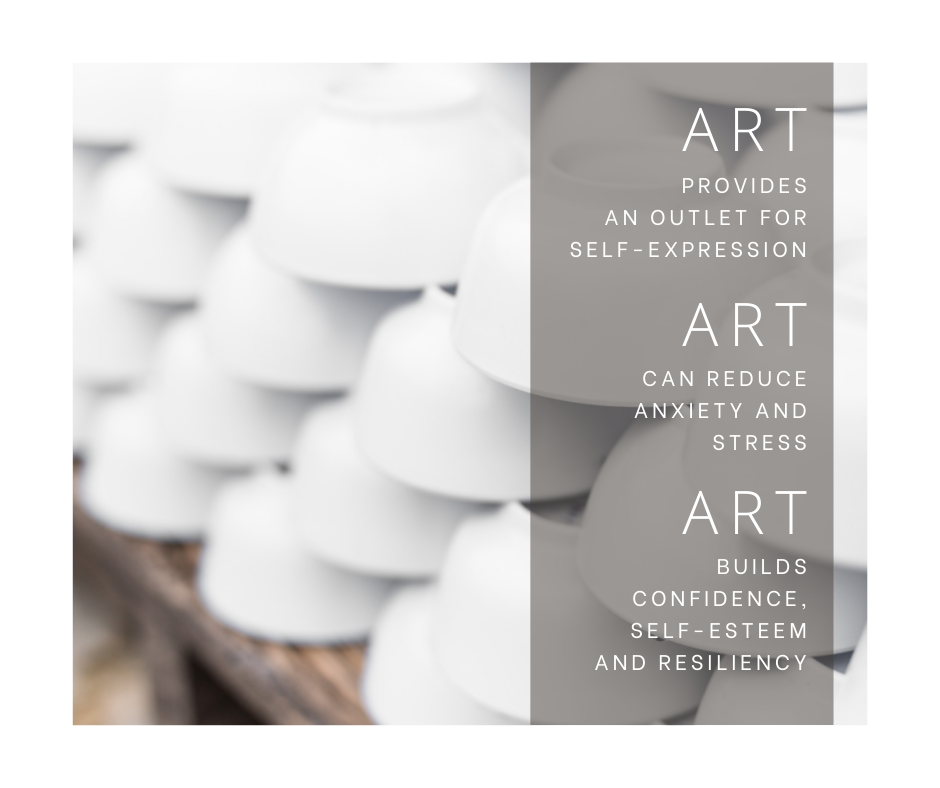A study was conducted with students 5 to 18 years old. When asked what they wanted to be when they grew up, researchers found that those interested in being an artist dramatically dropped starting at age 10. This can be attributed to more self-awareness of their talents, the ability to compare themselves to others (and other’s skills) and/or in response to influences in their upbringing and home life.
But really, why would any child – or adult for that matter – think they lack artistic talent? Being an artist is so much more than being able to draw or paint. Art is creativity, and creativity comes in so many forms. The obvious: creating through mediums like pen and paper, canvas and paint, photography, writing, design and composition.
Then there’s creativity for fun: molding clay, gardening, chalk on a sidewalk, rearranging your collectibles, planning a wall of your favorite photos, putting together a photo album, designing .. the list goes on and on.
As part of your own self-care, the importance (and massive health benefits!) of regularly practicing art and being creative has been studied and proven time and time again. Studies show that the levels of cortisol, a stress-related hormone, drastically drop when we spend time making art. Artistic or not, we all deal with stress. So maybe it’s time we explore the avenue of arts and creating as a form of self-care.
Art therapy is a long-standing mental health practice using art materials and creative expression to treat those who experience anxiety, depression, social difficulties or medical ailments. By creating art, no matter the skill level, we engage our mind, body, and spirit in a way that is restorative and comes with a host of benefits. Practicing art therapy helps to reduce stress and anxiety, while also increasing self-esteem.
When we create art, we’re able to look outside of ourselves and see the world around us with new eyes. We bring our attention to the piece we’re creating, or the photo we’re taking, and all the details that bring it to life. It’s a low-intensity act that doesn’t leave us feeling depleted, but instead soothed and more open-minded.
In the study highlighting how creating art lowers cortisol levels, it was uncovered that participants not only found the session relaxing and enjoyable, but also helpful in learning about new aspects of self. Without the normal constraints, they were able to indulge in a sense of flow and lose themselves in the work. Their sense of confidence was also impacted in that they left feeling interested in creating more art in the future.
Though we may not all have access to an art therapist, there are simple ways in which we can make it part of our daily lives. Here are some ideas for incorporating art and creativity into your self-care routine:

Visit your local paint-your-own pottery studio.
Studios provide everything you need to relax, have fun and engage with your creativity; supplies, instruction and inspiration are all at your disposal. From pottery painting to DIY projects, it’s the perfect place for a quiet afternoon alone or a fun outing with the family.
So much of what a studio offers is about the process: the creating. The designing. The planning and execution. Remember the levels of cortisol – those stress hormones? – and how they start dropping when you create? Well, you can feel it as you settle in and start painting.
Walk-ins are welcome; many studios are now offering to-go kits to enjoy the artistic process safely in your home.
Enroll in a beginner’s art class (or attend a paint and sip!).
Tapping into our creativity through art is also a great way to make our lives more social. We can build a connection with other like-minded individuals by joining a beginner’s art class, which can help with feelings of loneliness or social anxiety. Grab a friend and attending a paint and sip somewhere nearby! These sessions are generally guided by an instructor with an easy-to-follow piece of art. Many classes are now offered online!
Create a vision board.
They can be expanded upon throughout the year as your goals, dreams, and ambitions evolve. Vision boards help materialize the ideas we have in our minds and spark a sense of motivation.
Or keep it simple.
Using art as a means of self-care doesn’t have to be complicated. It can be as simple as doodling on a piece of paper or taking a pencil and drawing what’s in front of you for five minutes each day. The main goal is to free your mind and allow yourself the space for self-expression.
Self-care knows no bounds and doesn’t have to be limited to an idea of what others say you’re “supposed” to do. Take time to incorporate art and creativity into your routine weekly. It may just be what you’ve been searching for to unlock the sense of peace and clarity you desire.
Find your local paint-your-own pottery studio (many offer online sales and classes): https://paintyourownpottery.com/


